
 |
|
Star Wars: Episode I Cast: Liam Neeson, Jake Lloyd, Natalie Portman, Ewan McGregor, Pernilla August, Samuel L. Jackson, Ray Park. Voices: Ahmed Best, Frank Oz, Anthony Daniels, Kenny Baker. 1999 – 131 minutes Rated: Reviewed by Dustin Putman, May 20, 1999. 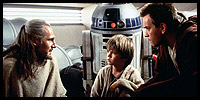 "Star Wars" fans across the nation have been waiting sixteen years for the promised prequels to the most popular series in motion picture history. The original trilogy somehow captured viewers' imaginations like no other movie possibly could, taking them on a wild ride through never-before-seen places and meeting unforgettable characters and creatures. The most die-hard fanatics have been sitting outside the Mann's Chinese Theater in L.A. for over a month, simply to be the first in line to see director-creator George Lucas' latest opus. On Wednesday, May 12, advance tickets went on sale at 3:00 p.m., and I was instantly in amazement, arriving at the theater almost two hours before the tickets were to be sold, to see a line going all the way around the building. Many people were said to have camped out overnight (and this is in the small town of Frederick, MD!), and the two guys next to me in line both said that they had called off work on that day. Ultimately, I waited three hours to get tickets to the 7:30 nighttime showing on "May 19," a date that will probably be forever ingrained in some peoples' minds. Expectations were so high for the film, with many nearly treating the impending release as "The Second Coming." On the other hand, I have never been that big of a fan of "Star Wars." I like them, and in the case of 1980's "The Empire Strikes Back," I nearly loved it, but I am far from a crazed devotee. I couldn't, however, pass up going to see this "Event" on the day it opened.
"Star Wars" fans across the nation have been waiting sixteen years for the promised prequels to the most popular series in motion picture history. The original trilogy somehow captured viewers' imaginations like no other movie possibly could, taking them on a wild ride through never-before-seen places and meeting unforgettable characters and creatures. The most die-hard fanatics have been sitting outside the Mann's Chinese Theater in L.A. for over a month, simply to be the first in line to see director-creator George Lucas' latest opus. On Wednesday, May 12, advance tickets went on sale at 3:00 p.m., and I was instantly in amazement, arriving at the theater almost two hours before the tickets were to be sold, to see a line going all the way around the building. Many people were said to have camped out overnight (and this is in the small town of Frederick, MD!), and the two guys next to me in line both said that they had called off work on that day. Ultimately, I waited three hours to get tickets to the 7:30 nighttime showing on "May 19," a date that will probably be forever ingrained in some peoples' minds. Expectations were so high for the film, with many nearly treating the impending release as "The Second Coming." On the other hand, I have never been that big of a fan of "Star Wars." I like them, and in the case of 1980's "The Empire Strikes Back," I nearly loved it, but I am far from a crazed devotee. I couldn't, however, pass up going to see this "Event" on the day it opened.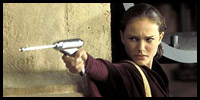 The film in question is, obviously, "Star Wars: Episode I - The Phantom Menace," set many years before the goings-on in the original trilogy, Episodes IV, V, and VI. Going in, I chose to not have any sort of expectations (although they admittedly were kind of low), but to simply hope the film would do its job in amazing and exciting me. Early critical reviews have not been very kind, but there have been a slew of overwhelmingly positive ones, including Roger Ebert and Janet Maslin (of "The New York Times"). And so, without any certain presumptions, the final word on "The Phantom Menace" is that it is perhaps the most visually astounding motion picture I have ever seen, far more stimulating than the previous "Star Wars" movies, due to such extravagant technological visual effects advancements since the late-'70s/early-'80s. Unfortunately, those movies by-and-large had one vital element that this movie is sorely lacking, and that is any sort of character involvement. While Han Solo, Luke Skywalker, and Princess Leia were likable characters with distinct personalities, "The Phantom Menace" holds no such close scrutiny. But then again, that leads to another predicament, which is that this film is only the first in a planned prequel trilogy, meaning that many of the characters will, no doubt, be further explored and development in the later installments, currently due out in theaters in 2002 and 2005. Problems abound in "The Phantom Menace," many more than there needed to be, but George Lucas truthfully had an overwhelming amount of elements to handle here, as he had to do the most difficult thing so far in the series, and that is to start it with the first vital chapter in the "Star Wars" legacy. You would be out of your league to say Lucas succeeded on every level, but he did do a respectable job, and treated me to extraordinary images that are worth the price of admission alone.
The film in question is, obviously, "Star Wars: Episode I - The Phantom Menace," set many years before the goings-on in the original trilogy, Episodes IV, V, and VI. Going in, I chose to not have any sort of expectations (although they admittedly were kind of low), but to simply hope the film would do its job in amazing and exciting me. Early critical reviews have not been very kind, but there have been a slew of overwhelmingly positive ones, including Roger Ebert and Janet Maslin (of "The New York Times"). And so, without any certain presumptions, the final word on "The Phantom Menace" is that it is perhaps the most visually astounding motion picture I have ever seen, far more stimulating than the previous "Star Wars" movies, due to such extravagant technological visual effects advancements since the late-'70s/early-'80s. Unfortunately, those movies by-and-large had one vital element that this movie is sorely lacking, and that is any sort of character involvement. While Han Solo, Luke Skywalker, and Princess Leia were likable characters with distinct personalities, "The Phantom Menace" holds no such close scrutiny. But then again, that leads to another predicament, which is that this film is only the first in a planned prequel trilogy, meaning that many of the characters will, no doubt, be further explored and development in the later installments, currently due out in theaters in 2002 and 2005. Problems abound in "The Phantom Menace," many more than there needed to be, but George Lucas truthfully had an overwhelming amount of elements to handle here, as he had to do the most difficult thing so far in the series, and that is to start it with the first vital chapter in the "Star Wars" legacy. You would be out of your league to say Lucas succeeded on every level, but he did do a respectable job, and treated me to extraordinary images that are worth the price of admission alone.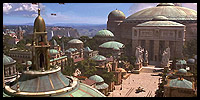 "Episode I" begins as The Trade Federation are preparing an attack on the planet of Naboo, headed by the 14-year-old Queen Amidala (Natalie Portman), whose life is in jeopardy. After a narrow escape from the Federation, who turn out to be more twisted and corrupt than expected, two Jedi Knights, the no-nonsense, scruffy Qui-Gon Jinn (Liam Neeson), and his apprentice, Obi-Wan Kenobi (Ewan McGregor), set off for Naboo to rescue the Queen and take her to Tatooine, a planet of safety. When their spacecraft breaks down, they venture out into a small desert town where they come into contact with two slaves, Shmi Skywalker (Pernilla August) and her 9-year-old son, Anakin (Jack Lloyd). Sensing the Force is with Anakin, and that he is destined to become a powerful Jedi, he hesitantly leaves behind his mother to join Qui-Gon and Obi-Wan, promising to return and set her free one day from a slave life.
"Episode I" begins as The Trade Federation are preparing an attack on the planet of Naboo, headed by the 14-year-old Queen Amidala (Natalie Portman), whose life is in jeopardy. After a narrow escape from the Federation, who turn out to be more twisted and corrupt than expected, two Jedi Knights, the no-nonsense, scruffy Qui-Gon Jinn (Liam Neeson), and his apprentice, Obi-Wan Kenobi (Ewan McGregor), set off for Naboo to rescue the Queen and take her to Tatooine, a planet of safety. When their spacecraft breaks down, they venture out into a small desert town where they come into contact with two slaves, Shmi Skywalker (Pernilla August) and her 9-year-old son, Anakin (Jack Lloyd). Sensing the Force is with Anakin, and that he is destined to become a powerful Jedi, he hesitantly leaves behind his mother to join Qui-Gon and Obi-Wan, promising to return and set her free one day from a slave life.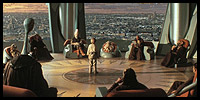 Since "The Phantom Menace" has the tiresome task of setting up everything to come later on, the villains come off more as an afterthought. The main one, I suppose, is Darth Maul (Ray Park), a fiendish sith with red-and-black face makeup, but he is literally given about four scenes and three lines of dialogue. How are we supposed to feel negatively towards Maul when we don't really even know who he is, and we never actually see him do any bad things, save for the inevitable climactic lightsaber battle between Qui-Gon, Obi-Wan, and himself? Villains probably aren't the point in this installment, though, and since they are so uninvolving and slight, it doesn't come off as a major problem.
Since "The Phantom Menace" has the tiresome task of setting up everything to come later on, the villains come off more as an afterthought. The main one, I suppose, is Darth Maul (Ray Park), a fiendish sith with red-and-black face makeup, but he is literally given about four scenes and three lines of dialogue. How are we supposed to feel negatively towards Maul when we don't really even know who he is, and we never actually see him do any bad things, save for the inevitable climactic lightsaber battle between Qui-Gon, Obi-Wan, and himself? Villains probably aren't the point in this installment, though, and since they are so uninvolving and slight, it doesn't come off as a major problem.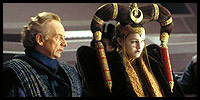 Sure, this movie is basically an arrangement for everything to come, but that still isn't an excuse for what does come off as a problem, and that is the performances, which are as lifeless as a piece of chopped-up wood. Neeson and McGregor are the centerpiece of the film, but we learn almost nothing about them, and they recite their lines without any feeling, as if their hearts weren't really into it. Maybe it is not the actors' faults, since they are so thinly written. At any rate, I'm sure McGregor felt especially out of place since he is a real actor, and probably not used to being what is essentially a background prop who stands there like a good boy and rarely says anything. Jake Lloyd, as young Anakin Skywalker, later to become Darth Vader, is an unctuous child actor if I ever saw one, with almost nary a line of dialogue that he is able to pull off. Surely, Lucas could have found a stronger, more assured actor to fit the bill of what is the most vital character in the film, as Lloyd is annoying and seemingly always aware that he is "in" a movie. Out of the four central roles, Natalie Portman easily fares best, but did you expect anything less of her? At 17-years-old, she is already a near-veteran, popping onto the scene in 1994 with her heartbreaking performance in "The Professional," and carrying it over to what was a performance snubbed of an Oscar nomination, in 1996's "Beautiful Girls." Portman knows how to make a scene work, even when the material isn't up to her level, and it will be intriguing to follow her character's development in Episodes II and III. Pernilla August, a Swedish actress in her first American film, is touching as Anakin's solemn, caring mother, and in each of her scenes she gives Neeson and Lloyd a run for their acting money. Also making brief appearances are Yoda (voiced by Frank Oz) and Mace Windu (Samuel L. Jackson), who sense an underlying uneasiness within Anakin, as well as friendly androids, R2-D2 (voiced by Kenny Baker) and an unfinished C-3P0 (voiced by Anthony Daniels). Brought to life as "Star Wars"'s first-ever major character that is completely computer-generated is the amphibious Jar Jar Binks (voiced by Ahmed Best) who, judging from his thick accent, must have been born and raised in the outskirts of Jamaica. Much talk has been raised about how Jar Jar is an annoying, kid-friendly addition to the film, and although he is probably more targeted for the children in the audience, I actually did like him, and his goofy, lovable nature. He is integrated seamlessly into each frame, never really looking like a special effect, and gives a better performance overall than any of the humans do.
Sure, this movie is basically an arrangement for everything to come, but that still isn't an excuse for what does come off as a problem, and that is the performances, which are as lifeless as a piece of chopped-up wood. Neeson and McGregor are the centerpiece of the film, but we learn almost nothing about them, and they recite their lines without any feeling, as if their hearts weren't really into it. Maybe it is not the actors' faults, since they are so thinly written. At any rate, I'm sure McGregor felt especially out of place since he is a real actor, and probably not used to being what is essentially a background prop who stands there like a good boy and rarely says anything. Jake Lloyd, as young Anakin Skywalker, later to become Darth Vader, is an unctuous child actor if I ever saw one, with almost nary a line of dialogue that he is able to pull off. Surely, Lucas could have found a stronger, more assured actor to fit the bill of what is the most vital character in the film, as Lloyd is annoying and seemingly always aware that he is "in" a movie. Out of the four central roles, Natalie Portman easily fares best, but did you expect anything less of her? At 17-years-old, she is already a near-veteran, popping onto the scene in 1994 with her heartbreaking performance in "The Professional," and carrying it over to what was a performance snubbed of an Oscar nomination, in 1996's "Beautiful Girls." Portman knows how to make a scene work, even when the material isn't up to her level, and it will be intriguing to follow her character's development in Episodes II and III. Pernilla August, a Swedish actress in her first American film, is touching as Anakin's solemn, caring mother, and in each of her scenes she gives Neeson and Lloyd a run for their acting money. Also making brief appearances are Yoda (voiced by Frank Oz) and Mace Windu (Samuel L. Jackson), who sense an underlying uneasiness within Anakin, as well as friendly androids, R2-D2 (voiced by Kenny Baker) and an unfinished C-3P0 (voiced by Anthony Daniels). Brought to life as "Star Wars"'s first-ever major character that is completely computer-generated is the amphibious Jar Jar Binks (voiced by Ahmed Best) who, judging from his thick accent, must have been born and raised in the outskirts of Jamaica. Much talk has been raised about how Jar Jar is an annoying, kid-friendly addition to the film, and although he is probably more targeted for the children in the audience, I actually did like him, and his goofy, lovable nature. He is integrated seamlessly into each frame, never really looking like a special effect, and gives a better performance overall than any of the humans do. If the characters are lacking depth and three dimensions, no one can accuse "Star Wars: Episode I - The Phantom Menace" of not being original and often awe-inspiring. The landscapes and marvelous city vistas are never anything less than powerful, majestic, and sumptuous, picture-perfect images that I could stare at for hours on end. Words really can't describe the visual experience of "The Phantom Menace," but every frame in the 131-minute movie is gorgeous to look at. Some images I will never forget include: the atmospheric, dreamy overhead views of the city skyscrapers in the planet, Coruscant; the endless green fields in Naboo where a climactic war is held; the Queen's kingdom, which is surrounded by curved, bubble-like buildings, as well as a crystal-clear waterfall leading into a river; and an underwater city in Naboo, populated by fish, giant water creatures, and Jar Jar Binks' own race of giant, floopy-eared pseudo-hares. "The Phantom Menace" is such an optical triumph that, like "Terminator 2"'s liquid-metal and "Jurassic Park"'s dinosaurs, stands as a new turning point in visual effects artistry, this time proving that every frame can look completely believable, as if no effects were even actually used. If I didn't know better, I'd say that Naboo, Tatooine, and the underwater city were actual places that exist.
If the characters are lacking depth and three dimensions, no one can accuse "Star Wars: Episode I - The Phantom Menace" of not being original and often awe-inspiring. The landscapes and marvelous city vistas are never anything less than powerful, majestic, and sumptuous, picture-perfect images that I could stare at for hours on end. Words really can't describe the visual experience of "The Phantom Menace," but every frame in the 131-minute movie is gorgeous to look at. Some images I will never forget include: the atmospheric, dreamy overhead views of the city skyscrapers in the planet, Coruscant; the endless green fields in Naboo where a climactic war is held; the Queen's kingdom, which is surrounded by curved, bubble-like buildings, as well as a crystal-clear waterfall leading into a river; and an underwater city in Naboo, populated by fish, giant water creatures, and Jar Jar Binks' own race of giant, floopy-eared pseudo-hares. "The Phantom Menace" is such an optical triumph that, like "Terminator 2"'s liquid-metal and "Jurassic Park"'s dinosaurs, stands as a new turning point in visual effects artistry, this time proving that every frame can look completely believable, as if no effects were even actually used. If I didn't know better, I'd say that Naboo, Tatooine, and the underwater city were actual places that exist.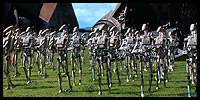 "The Phantom Menace," although more dialogue-oriented than action-inclined, as in 1977's "Star Wars," nonetheless includes some startling setpieces, including an exciting, superbly-crafted pod race that Anakin enters in with a pod he has made himself. Soaring through rock passageways and down cliffs, this sequence is the first true sign that we are back in "Star Wars" territory, and it is further carried out in the climax, which intercuts between three separate action storylines, including a war in the fields of Naboo between an army of robots from the Confederation and the amphibious Naboo residents; a fight to the death between Darth Maul, Qui-Gon Jinn, and Obi-Wan Kenobi; and the weak link, due to the corny, throwaway one-liners and weak acting by Lloyd, a space battle between Anakin and enemy troops.
"The Phantom Menace," although more dialogue-oriented than action-inclined, as in 1977's "Star Wars," nonetheless includes some startling setpieces, including an exciting, superbly-crafted pod race that Anakin enters in with a pod he has made himself. Soaring through rock passageways and down cliffs, this sequence is the first true sign that we are back in "Star Wars" territory, and it is further carried out in the climax, which intercuts between three separate action storylines, including a war in the fields of Naboo between an army of robots from the Confederation and the amphibious Naboo residents; a fight to the death between Darth Maul, Qui-Gon Jinn, and Obi-Wan Kenobi; and the weak link, due to the corny, throwaway one-liners and weak acting by Lloyd, a space battle between Anakin and enemy troops.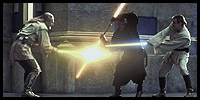 Flawed as it is, "Star Wars: Episode I - The Phantom Menace" captured my imagination and I enjoyed it. With a more tightly-written screenplay and characters, George Lucas would have really had something, but just as with "Episode IV," you have to look at the movie as a jumping-off point for the two later films, which most likely will be better on the story and, hopefully, on the performance levels. Going into "The Phantom Menace," I wasn't actually a "Star Wars" fan, but coming out I wanted more; I wanted to see what was going to happen next. "Episode II" may be three years away, but I'm already highly anticipating it, and the imperfections of "Episode I" have only sparked my interest even more since, like "The Empire Strikes Back," it is sure to be superior.
Flawed as it is, "Star Wars: Episode I - The Phantom Menace" captured my imagination and I enjoyed it. With a more tightly-written screenplay and characters, George Lucas would have really had something, but just as with "Episode IV," you have to look at the movie as a jumping-off point for the two later films, which most likely will be better on the story and, hopefully, on the performance levels. Going into "The Phantom Menace," I wasn't actually a "Star Wars" fan, but coming out I wanted more; I wanted to see what was going to happen next. "Episode II" may be three years away, but I'm already highly anticipating it, and the imperfections of "Episode I" have only sparked my interest even more since, like "The Empire Strikes Back," it is sure to be superior. |
© 1999 by Dustin Putman |














